

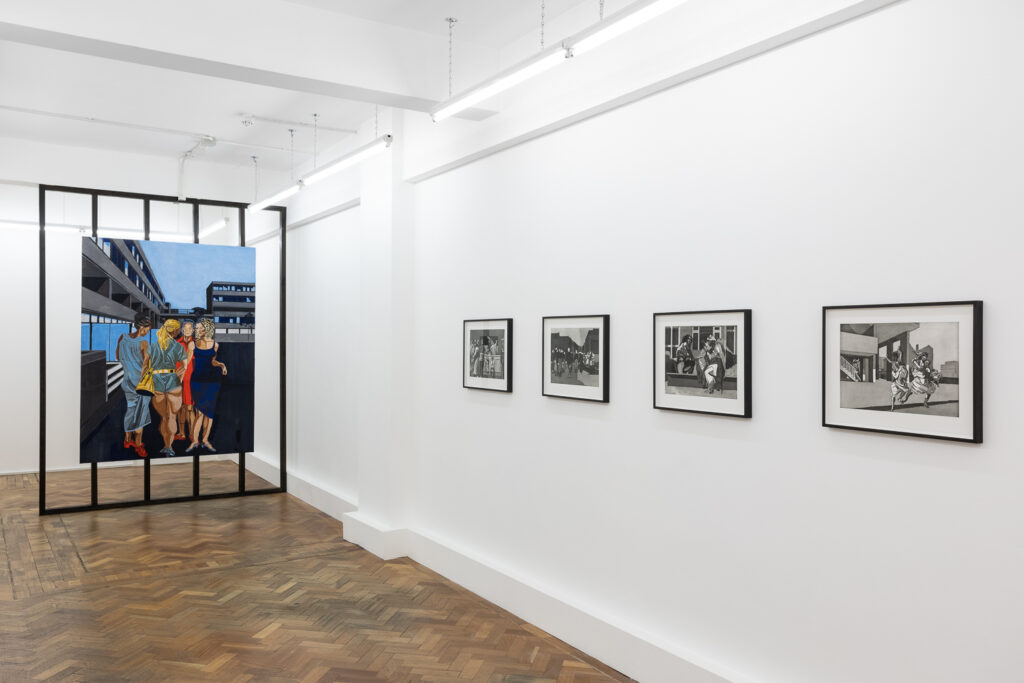
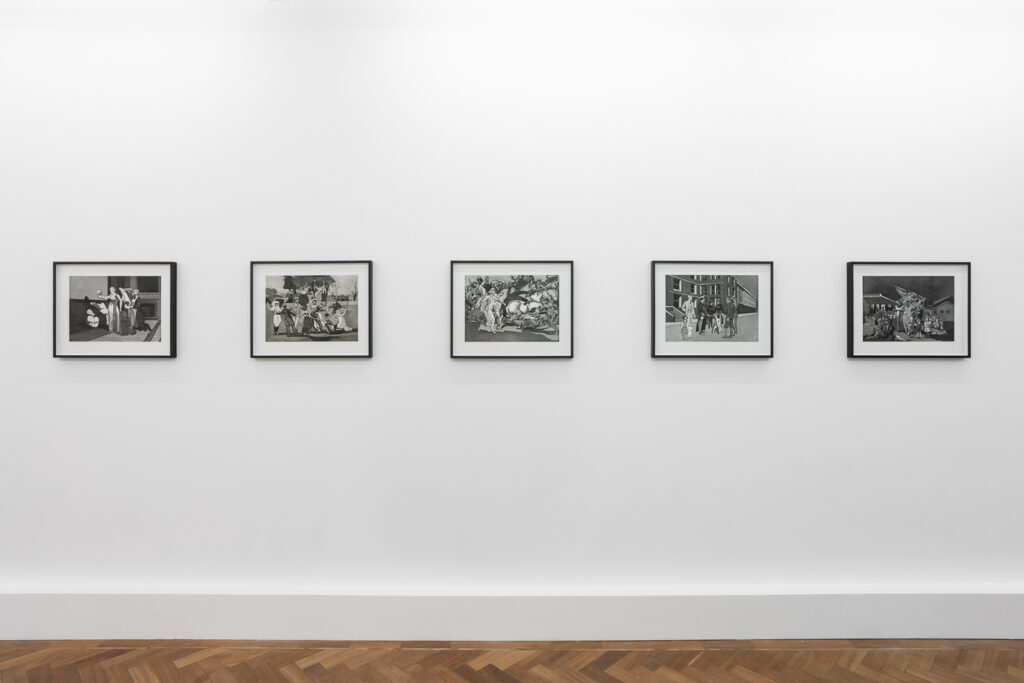

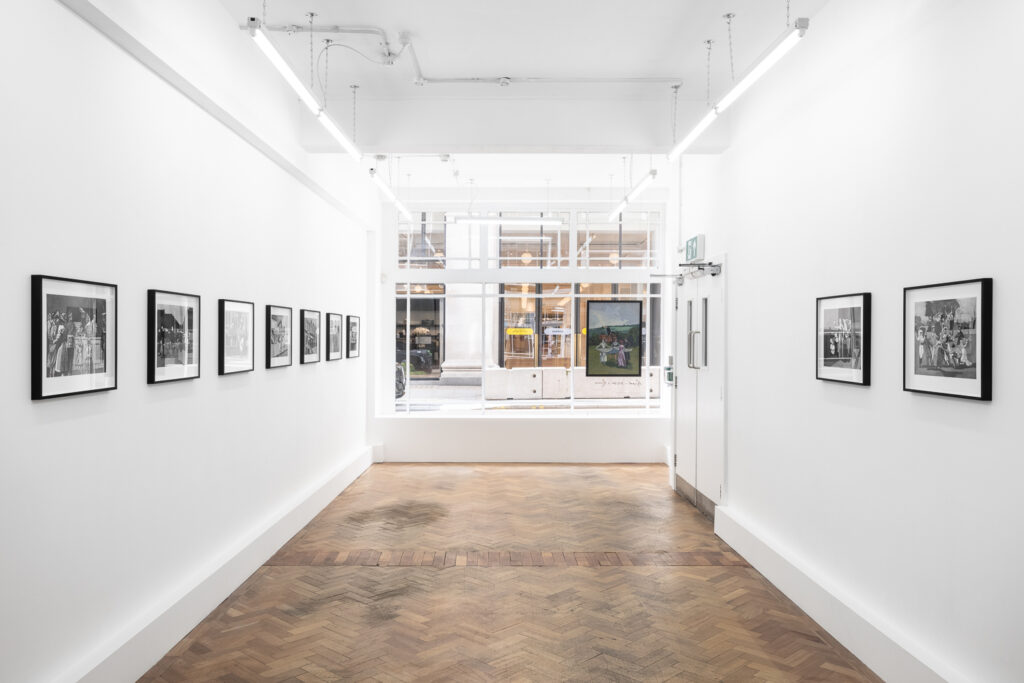


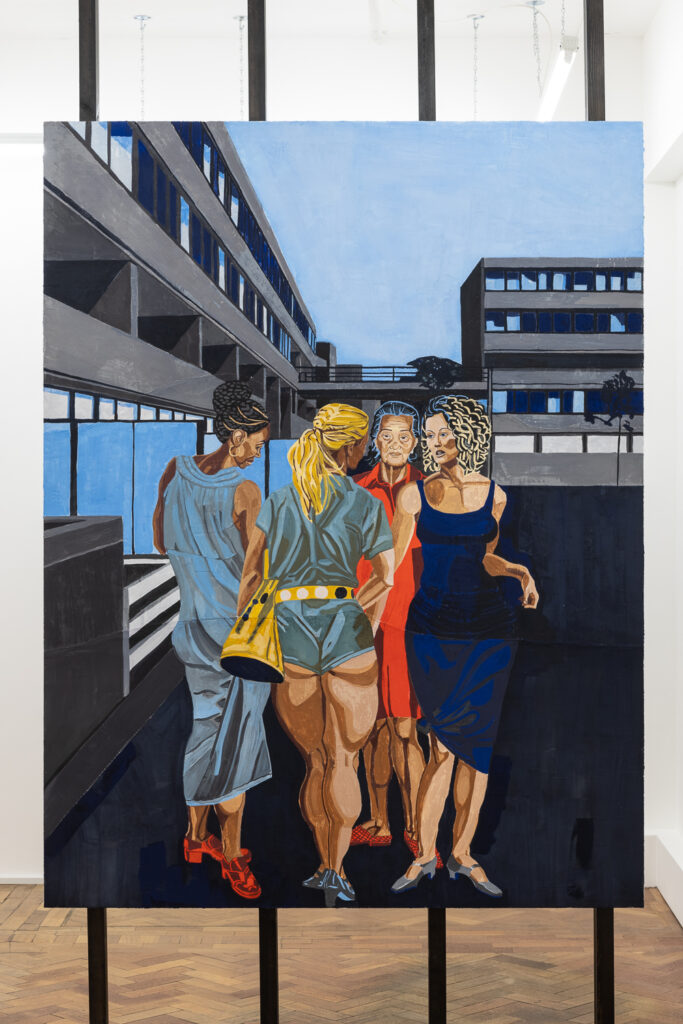
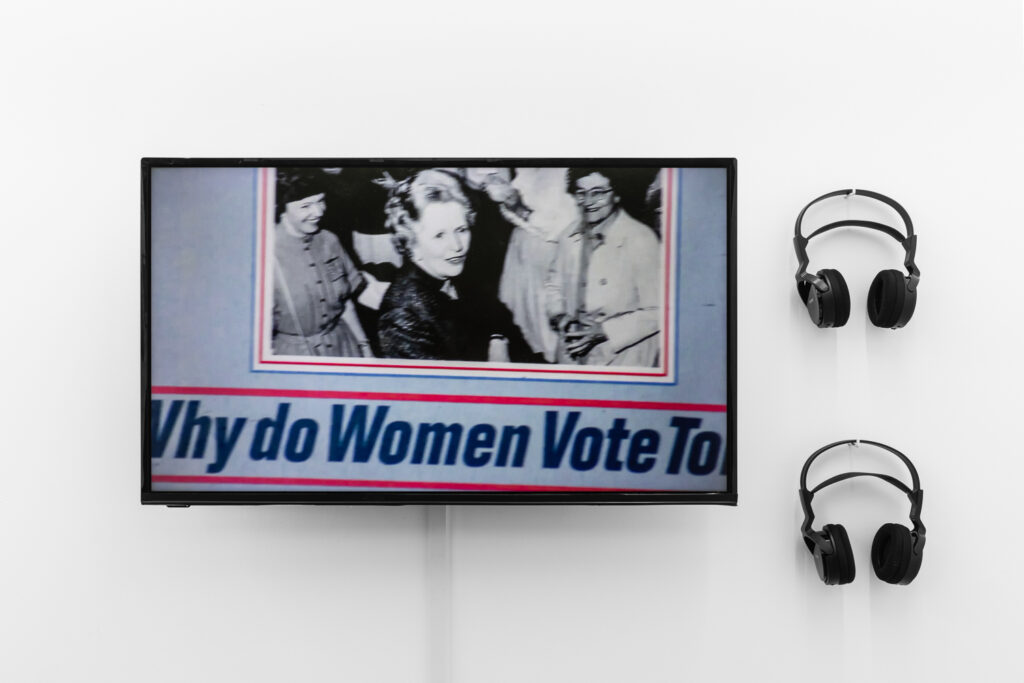

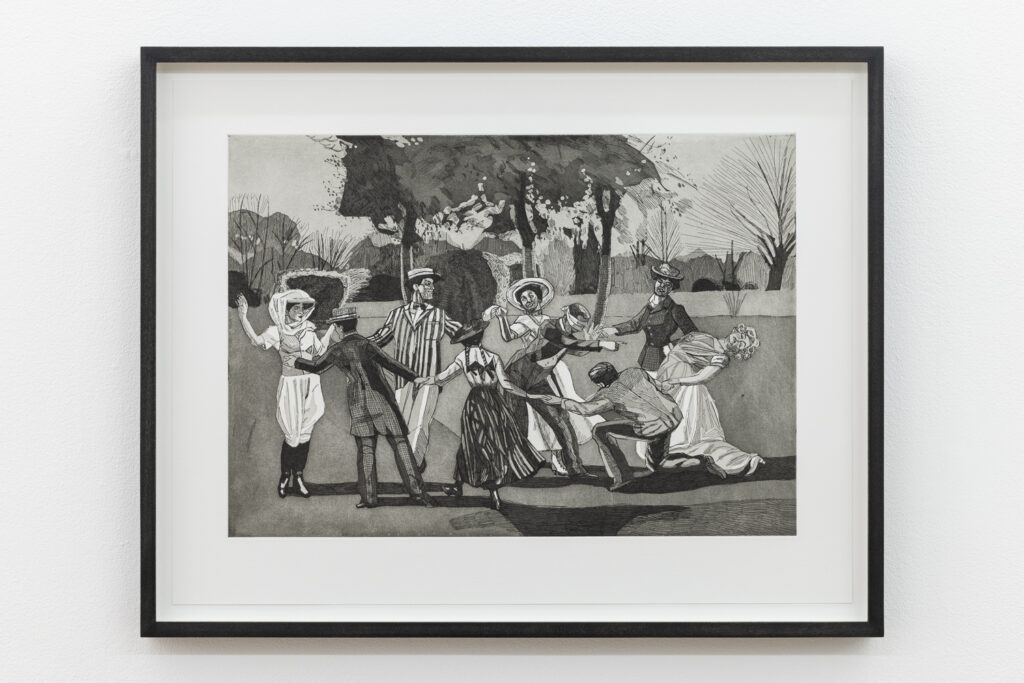

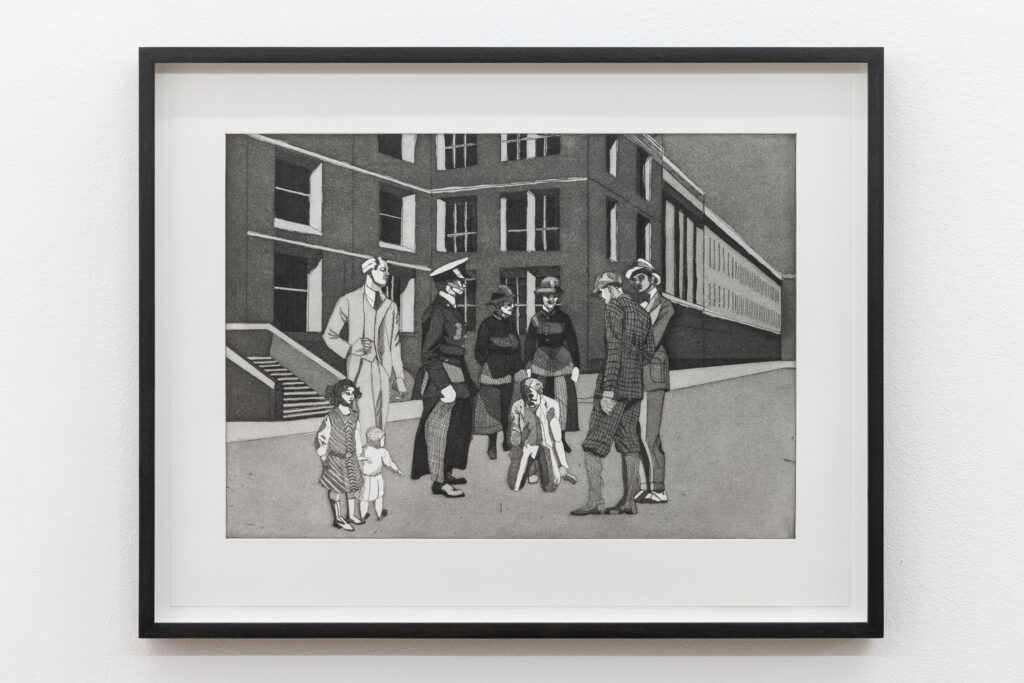


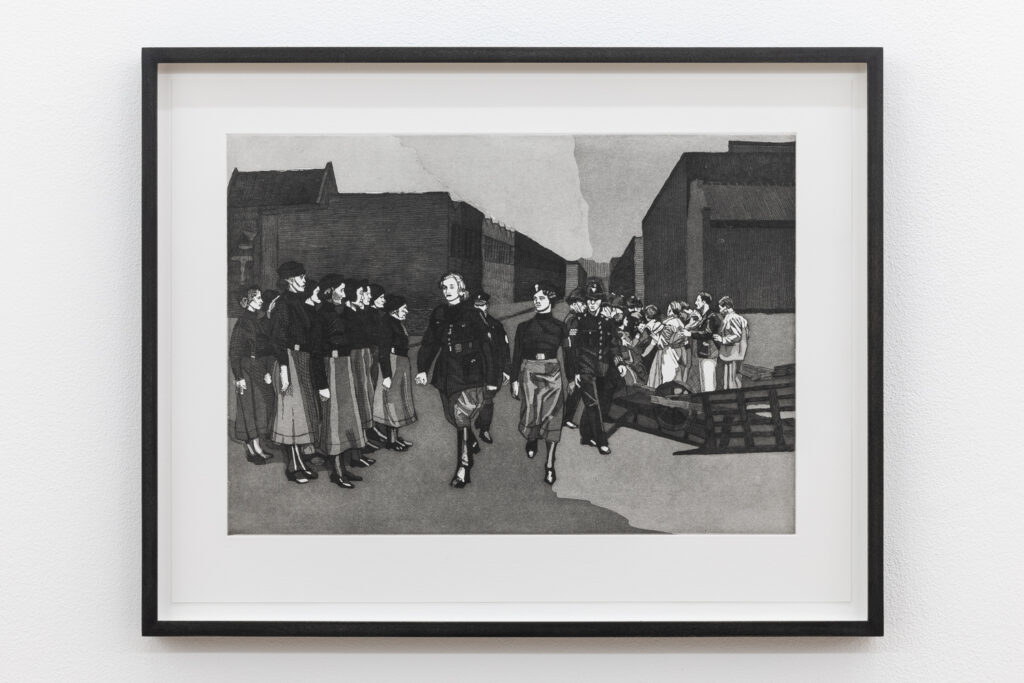



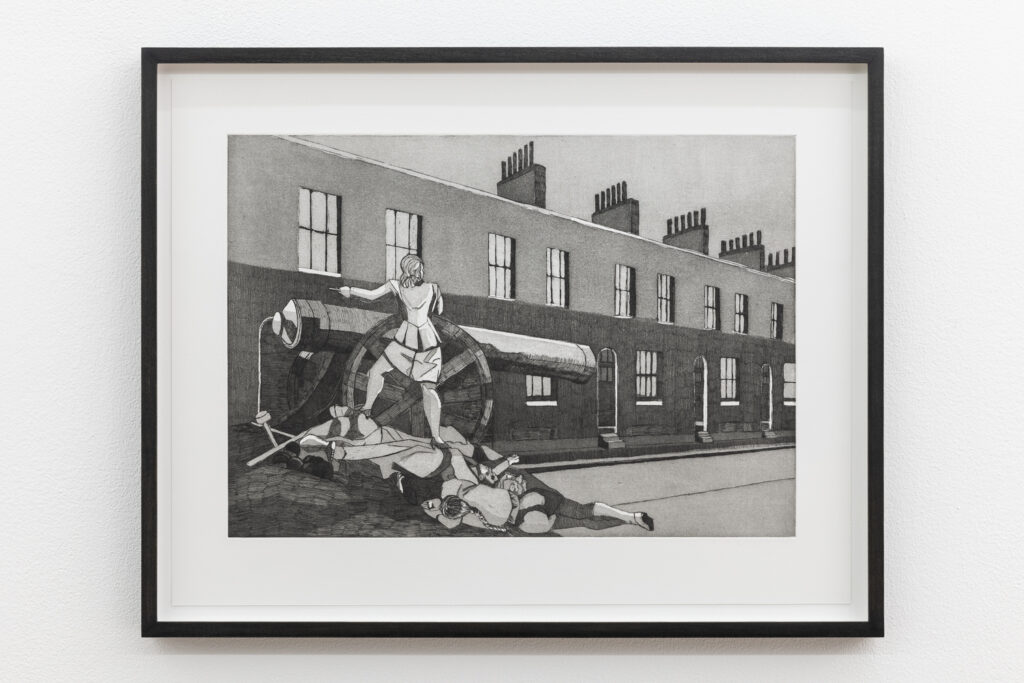

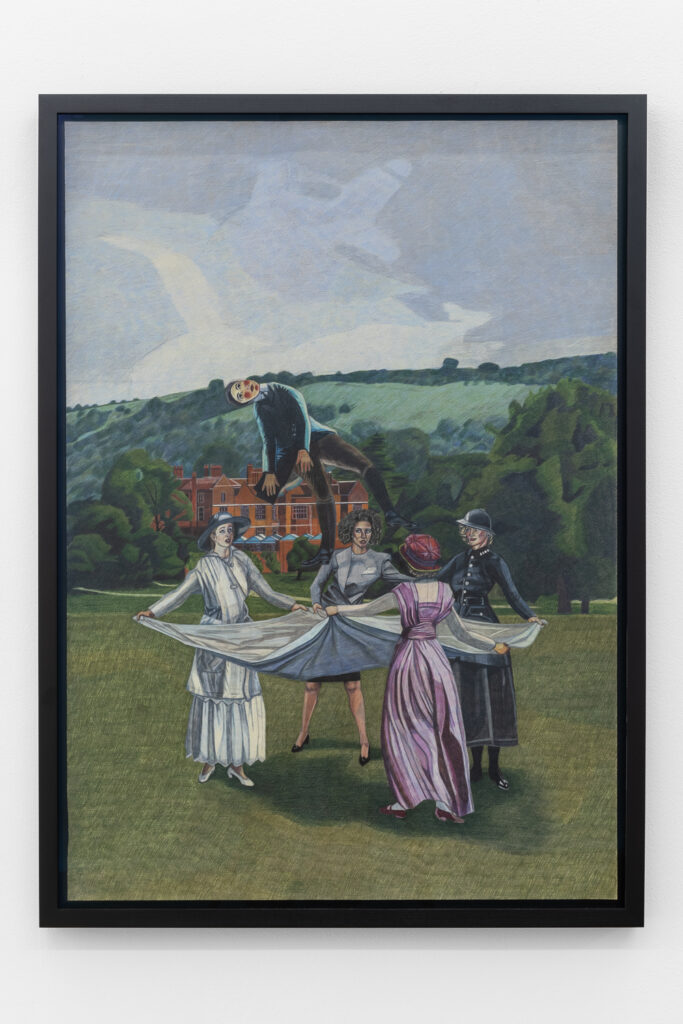

Arcadia Missa is proud to present Disgrace, a solo exhibition by Hannah Quinlan & Rosie Hastings. Containing a new body of works that includes a film, a fresco, two coloured pencil drawings and a series of twelve etchings, Disgrace explores the history of feminism on the political right in the UK, from the Edwardian period to today.
At the centre of the exhibition, the etchings are the artists’ construction of a specific feminist timeline, where each work is a vignette depicting a specific political and historical moment. The series of etchings is the centre point for the accompanying book to the exhibition, Disgrace: Feminism and the Political Right.
The timeline starts with women’s part in the British imperial project in the late 1800s, depicted in Imperial Ladies Auxiliary and Tea, garden & evening parties, rifle competitions, polo matches, the trooping of the colours and other special events, and ending with the last two etchings of the series, I’m not a woman I’m a conservative and We Will Not Be Silenced, which focus on Conservative groups such as Women2Win, co-founded by Theresa May and aimed at increasing the number of Conservative women in Parliament and in public life, and on TERFs (Trans-Exclusionary Feminists).
Several etchings take inspiration from the Women’s Suffrage Movement and expose its affiliation with conservative ideologies, such as through the Women’s Social and Political Union, which advocated for suffrage for female property owners, instead of for universal suffrage (as seen in Votes for Ladies) and into the realm of militarism through the Women’s Police Volunteers. Social Hygiene uncovers the beliefs and practices of the Eugenics Movement in the early 1900s and Blackshirts presents how in the 1930s and 1940s, many suffragettes went on to be affiliated with the British Union of Fascists.
In the etching Sex Wars, a clash between sex-positive campaigners and anti-pornography feminists in the 1980s is depicted, touching on a period in which anti-sex work campaigners identified women as objects of oppression who need to be protected, regardless of whether protection is wanted. The 1980s is also a decade of “free-market feminism” under UK Prime Minister Margret Thatcher, where putting certain women in positions was prioritised by some feminists over improving the lives of working people. For Quinlan and Hastings, these individualistic constructions of feminist progress persist, as seen in the aggressive rhetoric around immigration policy used by the Conservative government, which in turn is mirrored in the process of othering in trans-phobic feminist discourses – an ‘us’ versus ‘them’ mentality that promotes exclusionary and individualised notions of identity.
The compositions in Quinlan and Hastings’ work are populated with symbolism and playful references to art history. Freemarket Feminism is a nod to an etching from Goya’s series The Disasters of War, while a painting by Goya, Straw Manikin, is behind the composition of the drawing The whole world may, perhaps, be rather a large country house, which shows figures from the various periods referenced in the etchings playing blanket-tossing with a doll. In the background stands Chequers, the country house of the UK Prime Minister.
In the office, the drawing Mother functions much like an origin story of women’s political emancipation. Inspired by the 12 Labours of Hercules, it shows a woman in an opulent Edwardian dress standing in front of her manor house, having just captured a bull; her authority and strength are viewed in relation to her class as a property owner.
The fresco Republic #2 describes an imaginary scene, one set in a 1970s housing estate where four women are conversing. Standing at near life-sized, they convey a sense of power and freedom, opening up a space for possibilities outside of the realities depicted in the other works.
Finally, the video Portraits shows a collection of filmed footage shot in various locations during the months of research that the artists did for the exhibition, including Stafford Terrace and the doll’s house museum of Leonardslee Gardens.
Together the works in Disgrace outline a history of feminism as it intersects and entwines with the violence and oppression of colonialism, capitalism and neoliberalism. Disgrace ‘charges us, as women committed to the liberation of women, to know the past in order to consider what we want to conserve and what we want not to repeat or continue’. (Adrien Rich, A. Blood, bread and poetry. 1987. Virago Press, 146.)
Exhibition credits:
Film edited by: Mateo Villanueva Brandt
Film Audio by: Owen Pratt
Etchings printed at: Thumbprint Editions Ltd
List of works (from left to right, starting with the full series of etchings):
Imperial Ladies Auxiliary, 2021
Hard ground etching with aquatint on Hahnemuhle copperplate white 300gsm paper, framed
38.7 × 50 cm (15 ¼ × 19 ⅝ inches)
43 × 54 × 3 cm (16 ⅞ × 21 ¼ × 1 ⅛ inches) (framed)
Tea, garden & evening parties, rifle competitions, polo matches, the trooping of the colours and other special events,
2021 Hard ground etching with aquatint on Hahnemuhle copperplate white 300gsm paper, framed
38.7 × 50 cm (15 ¼ × 19 ⅝ inches)
43 × 54 × 3 cm (16 ⅞ × 21 ¼ × 1 ⅛ inches) (framed)
For Ladies, 2021
Hard ground etching with aquatint on Hahnemuhle copperplate white 300gsm paper, framed
38.7 × 50 cm (15 ¼ × 19 ⅝ inches)
43 × 54 × 3 cm (16 ⅞ × 21 ¼ × 1 ⅛ inches) (framed)
Women’s Police Volunteers, 2021
Hard ground etching with aquatint on Hahnemuhle copperplate white 300gsm paper, framed
38.7 × 50 cm (15 ¼ × 19 ⅝ inches)
43 × 54 × 3 cm (16 ⅞ × 21 ¼ × 1 ⅛ inches) (framed)
Social Hygiene, 2021
Hard ground etching with aquatint on Hahnemuhle copperplate white 300gsm paper, framed
38.7 × 50 cm (15 ¼ × 19 ⅝ inches)
43 × 54 × 3 cm (16 ⅞ × 21 ¼ × 1 ⅛ inches) (framed)
Empire Cake, 2021
Hard ground etching with aquatint on Hahnemuhle copperplate white 300gsm paper, framed
38.7 × 50 cm (15 ¼ × 19 ⅝ inches)
43 × 54 × 3 cm (16 ⅞ × 21 ¼ × 1 ⅛ inches) (framed)
Blackshirts, 2021
Hard ground etching with aquatint on Hahnemuhle copperplate white 300gsm paper, framed
38.7 × 50 cm (15 ¼ × 19 ⅝ inches)
43 × 54 × 3 cm (16 ⅞ × 21 ¼ × 1 ⅛ inches) (framed)
Gatekeeper, 2021
Hard ground etching with aquatint on Hahnemuhle copperplate white 300gsm paper, framed
38.7 × 50 cm (15 ¼ × 19 ⅝ inches)
43 × 54 × 3 cm (16 ⅞ × 21 ¼ × 1 ⅛ inches) (framed)
Sex Wars, 2021
Hard ground etching with aquatint on Hahnemuhle copperplate white 300gsm paper, framed
38.7 × 50 cm (15 ¼ × 19 ⅝ inches)
43 × 54 × 3 cm (16 ⅞ × 21 ¼ × 1 ⅛ inches) (framed)
Free-market, 2021
Hard ground etching with aquatint on Hahnemuhle copperplate white 300gsm paper, framed
38.7 × 50 cm (15 ¼ × 19 ⅝ inches)
43 × 54 × 3 cm (16 ⅞ × 21 ¼ × 1 ⅛ inches) (framed)
I’m not a woman I’m a conservative, 2021
Hard ground etching with aquatint on Hahnemuhle copperplate white 300gsm paper, framed
38.7 × 50 cm (15 1/4 × 19 5/8 inches)
43 × 54 × 3 cm (16 7/8 × 21 1/4 × 1 1/8 inches) (framed)
We Will Not Be Silenced, 2021
Hard ground etching with aquatint on Hahnemuhle copperplate white 300gsm paper, framed
38.7 × 50 cm (15 1/4 × 19 5/8 inches)
43 × 54 × 3 cm (16 7/8 × 21 1/4 × 1 1/8 inches) (framed)
Elsewhere in the gallery:
The whole world may, perhaps, be rather a large country house, 2021
Coloured pencil on paper
84 × 51 cm (33 1/8 × 20 1/8 inches)
90 × 65.5 × 5 cm (35 3/8 × 25 3/4 × 2 inches) (framed)
Republic #2, 2021
Pigment on plaster board
200 × 150 × 4.5 cm (78 3/4 × 59 × 1 3/4 inches)
Portraits, 2021
HD video with sound
6 minutes 27 seconds
Office:
Mother, 2021
Coloured pencil on paper
150 × 110 cm (59 × 43 ¼ inches)
156 × 115.5 × 5 cm (61 ⅜ × 45 ½ × 2 inches) (framed)